Viewing search results for "University of North Carolina at Chapel Hill"
View All Posts

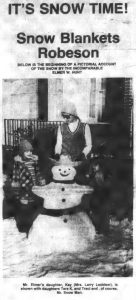
A snow celebration in the February 22, 1979 issue
Almost two decades of the newspaper The Carolina Indian Voice, from 1977-1996, are now up on DigitalNC. Provided by our partner, UNC at Chapel Hill, this batch joins previously digitized issues that date from 1996-2005. The Carolina Indian Voice was established in 1973 and continued through 2005, so now nearly the entire print run is digitized.
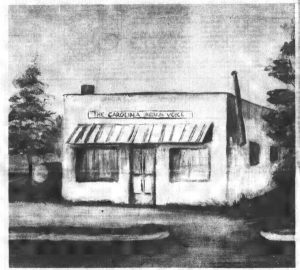
A painting of the Carolina Indian Voice building as shown in the January 10, 1980 issue
The Carolina Indian Voice is one of North Carolina’s oldest American Indian newspapers. It served members of the Lumbee Tribe living in Robeson County including the town of Pembroke, which is the seat of the Lumbee tribe of North Carolina, as well as the home of The University of North Carolina at Pembroke, a historically American Indian University.
The Carolina Indian Voice was published weekly on Thursdays and was a source for all sorts of local news. Topics covered included local politics and civic issues, cultural events, school happenings, and more. Articles on local and national civil rights issues and efforts to end racial discrimination pertinent to Robeson County’s American Indian population were also covered alongside everyday happenings in the county.

An article on H.R. 12996 regarding federal recognition of American Indian tribes in the August 24, 1978 issue
Click here to take browse through the digitized issues. To see more materials from our partner UNC at Chapel Hill, visit their DigitalNC partner page or take a look at their website.
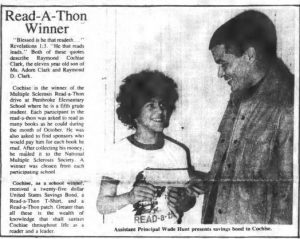
The fifth grade winner of the Pembroke Elementary Read-A-Thon in the December 8, 1977 issue
A new batch of materials from our partner, The Grand Lodge of Ancient, Free and Accepted Masons of North Carolina are now up on DigitalNC. This set includes minute books, scrapbooks, historical manuscripts, letters and charters, some dating back to the 18th century. Several physical artifacts have been digitized, including a commemorative apron and a souvenir pin from the turn of the 20th century.
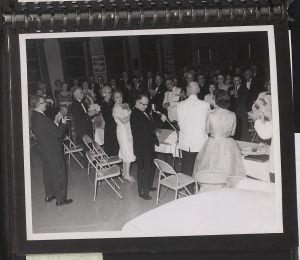
A celebration for the installation of James Brewer as Grand Master in 1961.
The minute books are from all around the state, including Chapel Hill, Charlotte, Statesville and Boone. Also included is a letter from Edward K. Graham, President of UNC, to Grand Master Andrews inviting him to the 1916 University Day ceremony. There are also several scrapbooks included, with photographs including receptions and various programs, including the 275th Anniversary of the United Grand Lodge of England in West London in June 1992.
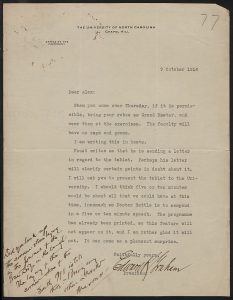
UNC President Edward K. Graham inviting Grand Master Andrews to wear his Masonic regalia to the 1916 University Day ceremony
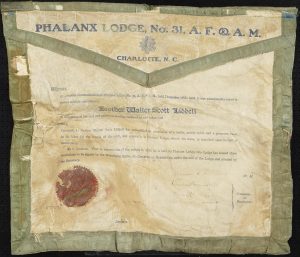
Commemorative apron honoring the services of Walter Scott Liddell
To see more materials from The Grand Lodge of Ancient, Free and Accepted Masons of North Carolina, visit their partner page or take a look at their website or our previous blog posts.

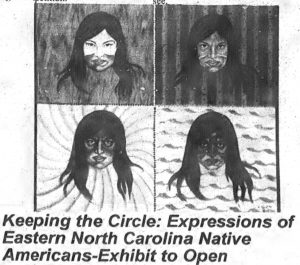
Headline from the September 24, 1998 issue of The Carolina Indian Voice.
Almost ten years of The Carolina Indian Voice, a newspaper out of Pembroke, North Carolina, are now up on DigitalNC thanks to our partner the University of North Carolina at Chapel Hill. The Carolina Indian Voice was established in 1973 and was published on a weekly basis until 2005. Issues from 1996-2005 are now available digitally. The paper primarily served the interests of members of the Lumbee Tribe living in Robeson County, who make up more than a third of the population of Robeson County and almost 90% of the town of Pembroke.
The paper includes articles and editorials concerning local issues such as politics, social events, civic projects, and more. Although there is a strong focus specifically on issues relevant to members of the Lumbee Tribe, the paper also covers news and events pertaining to American Indians throughout the state of North Carolina and nationally.
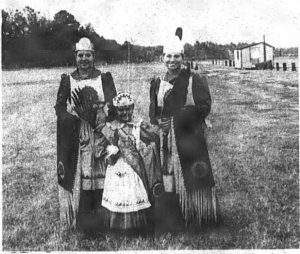
Image from the 1998 First Annual Fall Pow Wow in Hoke County as seen in the November 11, 1998 issue of The North Carolina Indian Voice.

Headline from the February 25, 1999 issue of The North Carolina Indian Voice.
The paper also focuses on advocacy with many articles covering struggles against the discrimination American Indians face regarding employment, education, and housing in the United States.
To browse through issues of The North Carolina Indian Voice click here. To see more materials from our partner, the University of North Carolina at Chapel Hill, visit their partner page.
Mascots are a complicated phenomenon. They inspire a spectrum of reactions: ridicule, ambivalence, or fierce loyalty. With thousands of yearbooks online, all of us here at the Digital Heritage Center have probably spent more time looking at yearbooks than anyone else you’re likely to meet. Mascots are a common theme.
I’ve been working on today’s post for quite some time; unable to find a history or comprehensive list of mascots in North Carolina I decided to compile one myself. So here’s a stab at a college mascot overview, drawn from yearbooks and other campus publications. Let me know what I’ve missed or gotten wrong!
Children
In the early 20th century, schools frequently chose children as mascots or sponsors, whether for a sports team or for a particular class. The earliest example we’ve found on DigitalNC is from a 1910 publication by Atlantic Christian College (now Barton College) in Wilson, which shows Elizabeth Settle Caldwell as the Senior Class sponsor.
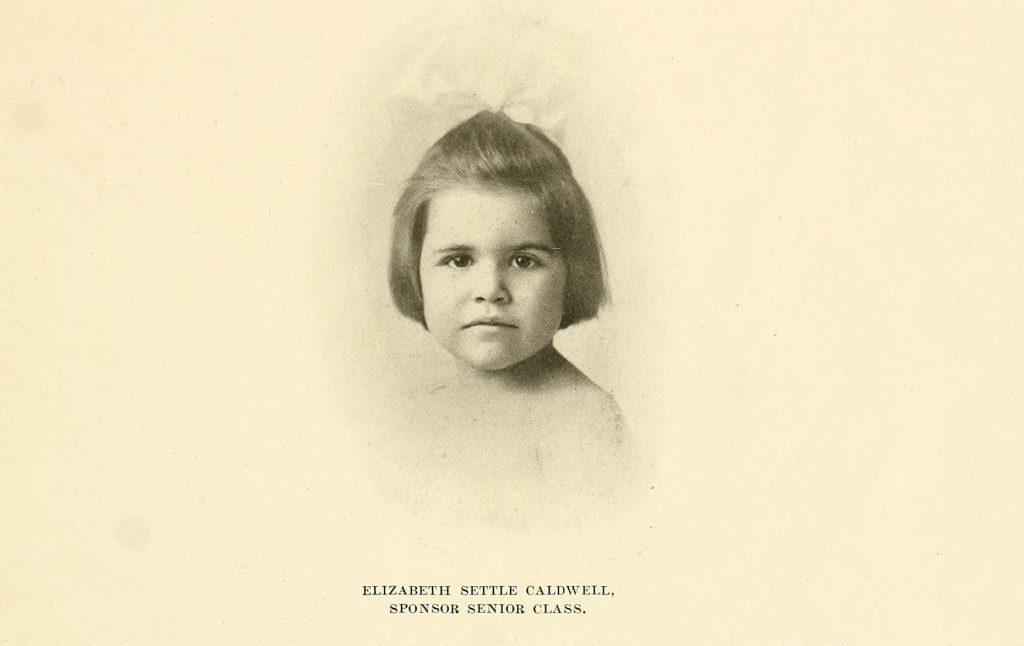
Elizabeth Settle Caldwell, First North Carolina Mascot? From the 1910 Pine Knot yearbook, Atlantic Christian College.
Ms. Caldwell was the daughter of Jesse Cobb Caldwell, the college president. From what we’ve been able to tell, children mascots were frequently younger siblings of students, teachers, or others associated with the school. Students mention that Ms. Caldwell brought “solace to many a lonely, homesick heart” and this may be why children were chosen – to foster a feeling of family and comfort among students. We’ve seen several references to mascots being elected or being chosen through competition, although what this might be we haven’t been able to discover. The trend of choosing children as mascots seems to continue through the 1960s. The latest one we found is Dawn, the Senior Class mascot at Peace College (now William Peace University) in 1966.
Animals
Animal mascots span schools across the state, whether it’s Rameses at UNC-Chapel Hill or WCU’s Catamount. The bulldog and different types of cats win out as most frequently adopted. Pictures of live animal mascots start to appear in yearbooks in the early 1900s, and continue today although much less frequently. For a variety of reasons, including concerns expressed by animal rights activists, schools have shifted away from actual animals to students dressing up like animals, as you’ll see later on in this post.
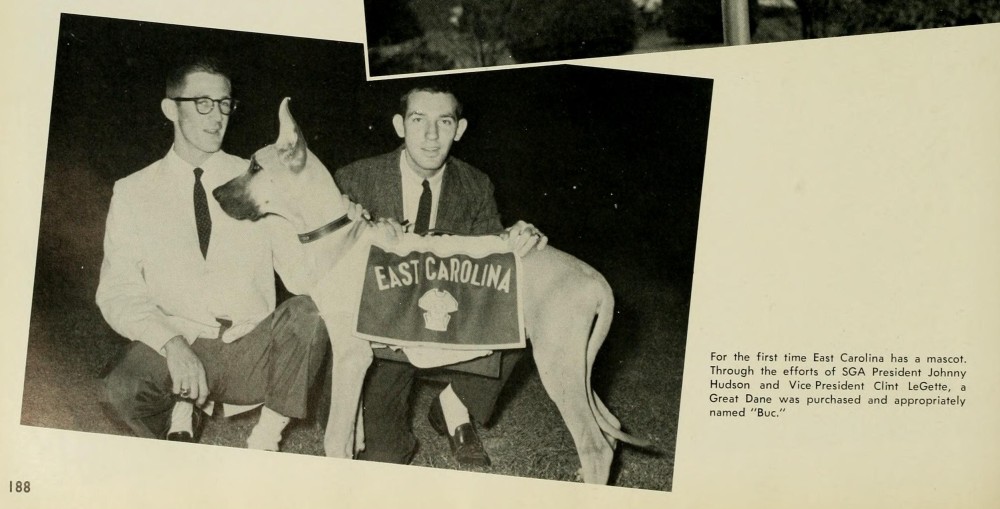
“Buc” is described here as East Carolina University’s first mascot. From the 1959 Buccaneer yearbook.
Characters
While about half of the four-year college mascots in North Carolina are animals, most of the others are characters that are historic, mythical, or extraordinary in nature. From what I’ve seen in NC yearbooks, humans dressing up as the school mascot really got traction in the 1960s. Initially, these costumes weren’t the fuzzy creations we think of today, but rather less complicated ensembles where the mascot’s identity (his or her face and body) was often apparent. Yosef the Mountaineer, beloved icon of Appalachian State University, was created sometime around 1942 and looked like this in the 1960s:
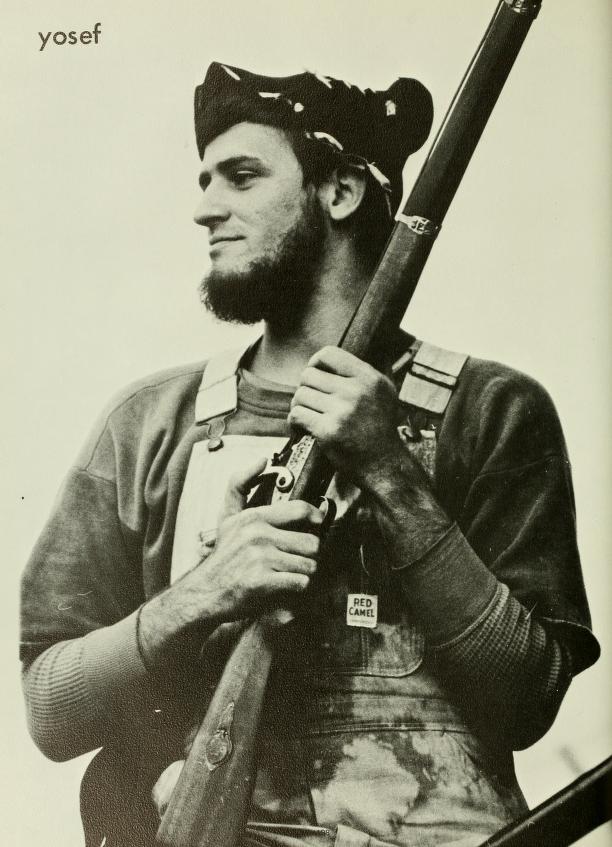
Yosef the Mountaineer, aka James Randle Tedder (we think). From the 1969 Rhododendron yearbook, Appalachian State University.
One of my favorites has to be this picture of Duke Blue Devil, from 1950:
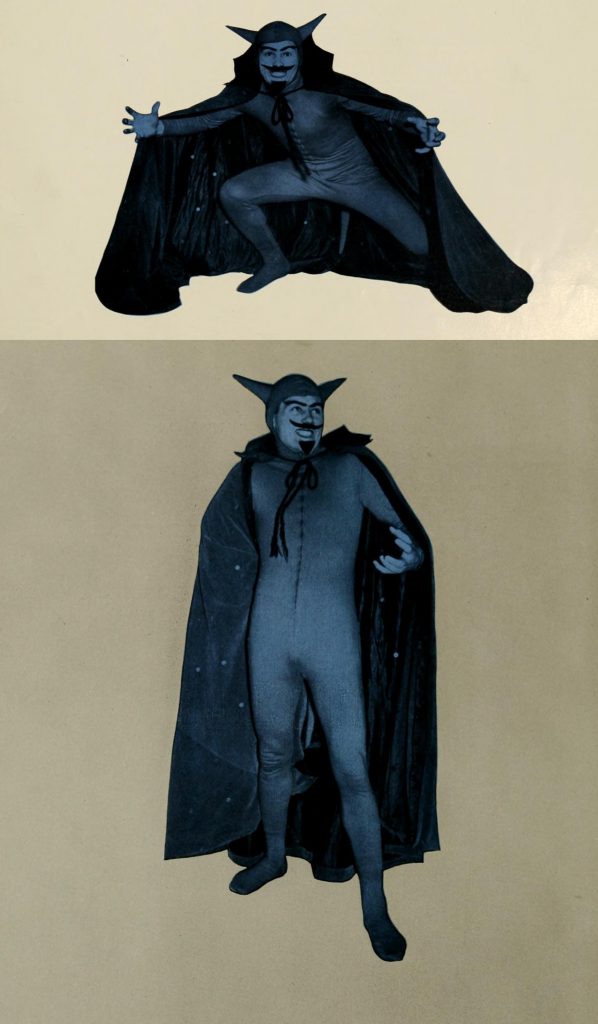
The Blue Devil. From the 1950 Chanticleer yearbook, Duke University.
Perhaps it was too hard to maintain a degree of consistency as students graduated over the years, and mascot anonymity seemed like a better idea. Whatever the reason, you start to see fuzzy, oversized costumes with gigantic headpieces in the late 1970s.
The Big Costumes
Whether animal or character, plush mascots that include a single piece body suit with a large plastic or cloth-covered head is something most Americans can identify with, thanks to professional sports. Colleges in North Carolina really embraced these costumes through the 1980s. Here’s what the UNC-Wilmington Seahawk looked like in 1987:

The Seahawk. From the 1987 Fledgling yearbook, UNC-Wilmington.
Some schools have developed multiple mascots dedicated to different audiences. It seems like the difficulty with these types of costumes is how to pull off a fierce facial expression that doesn’t come off as goofy or too scary for children. I think this picture from Davidson College sums it all up:
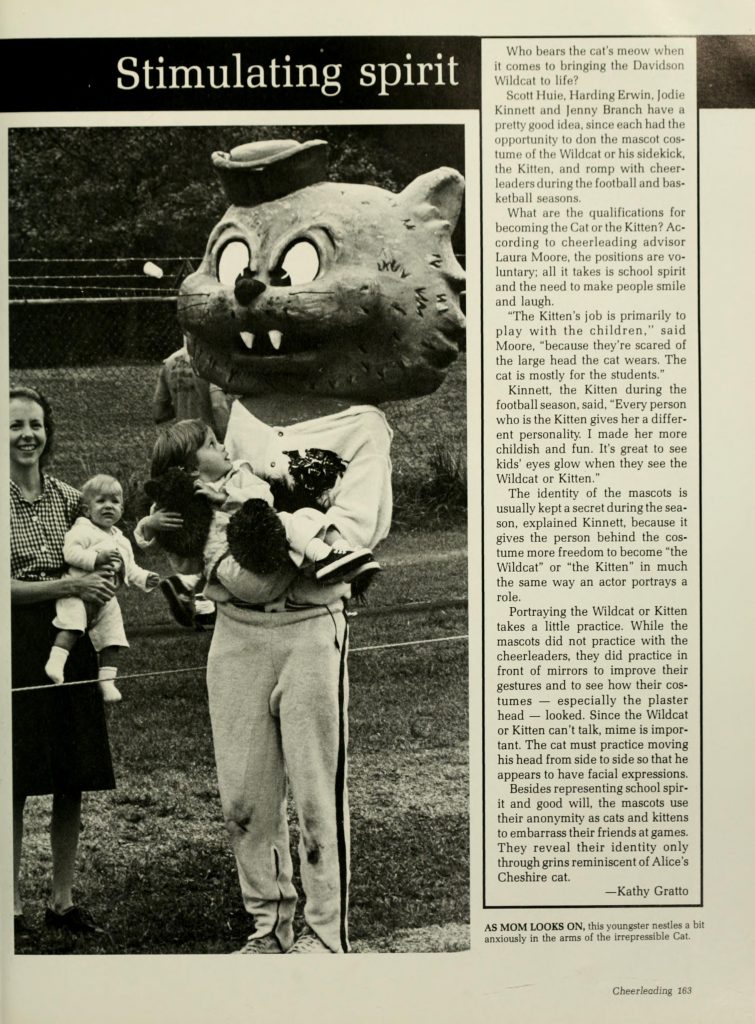
The Davidson Wildcat and … friends. From the 1983 Quips and Cranks yearbook.
I will also take this opportunity to mention a mascot that routinely makes the “wait … what?” list – the Campbell University Fighting Camels:
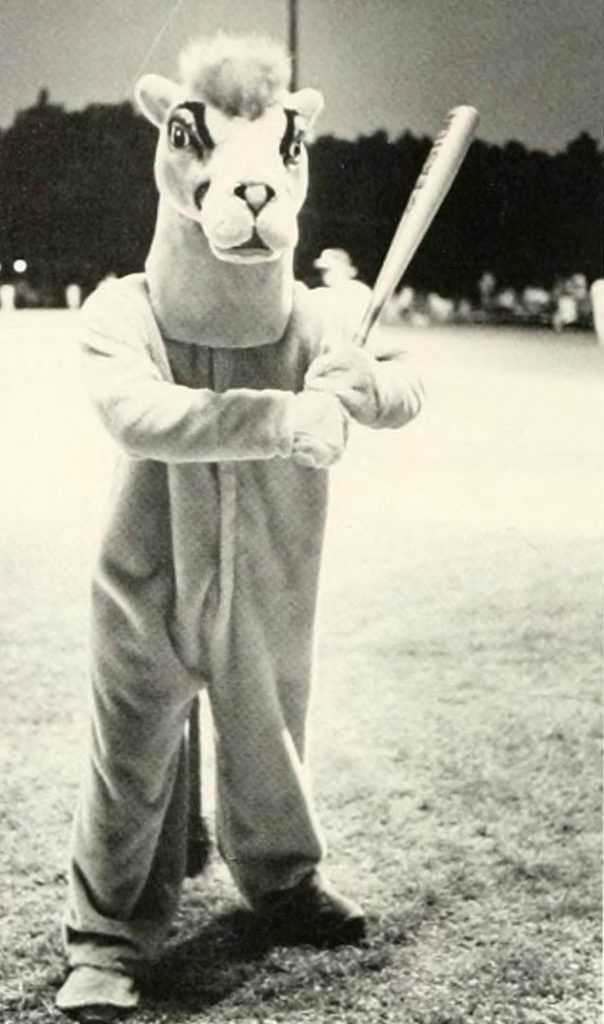
The Campbell Camel. From the 1983 Pine Burr yearbook.
Even the humans and human-like creatures are clothed in oversized costumes these days. Wake Forest University’s Deacon is a dapper chap:
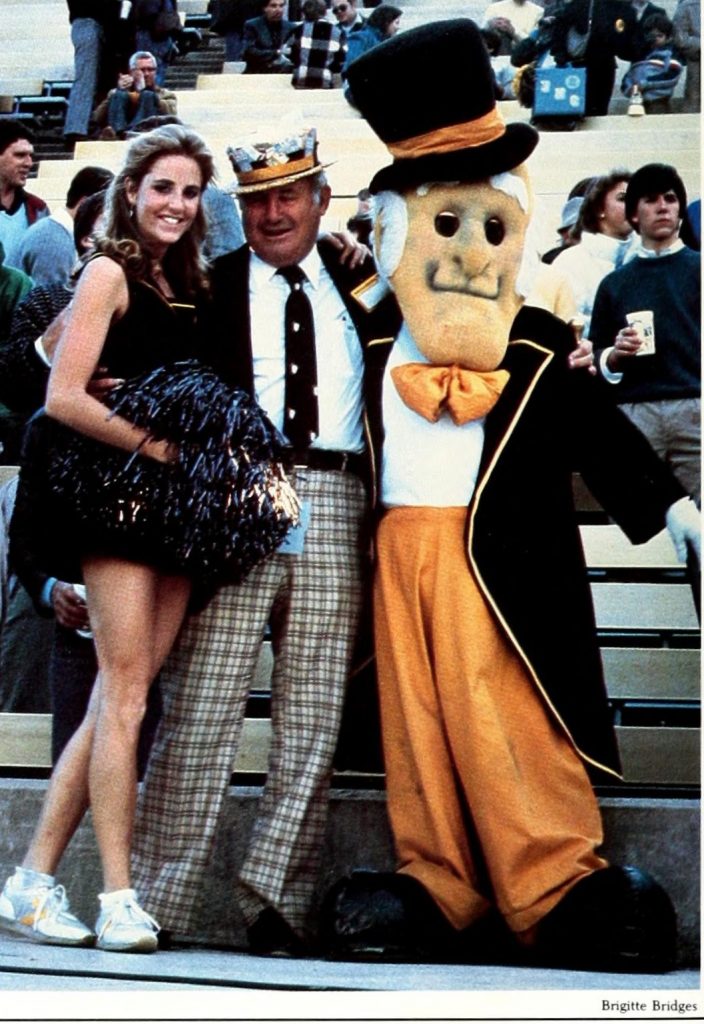
Wake Forest’s Deacon poses with fans. From the 1985 Howler yearbook.
In addition to the Demon Deacons and the Blue Devils, North Carolina boasts a number of other spiritual mascots: North Carolina Wesleyan’s Battling Bishops, Belmont Abbey’s Crusaders, and Guilford College’s Quakers. Meredith College’s teams are known as the Avenging Angels (formerly just the Angels). While Elon University’s mascot is now the Phoenix, before 2000 they were the Fighting Christians:
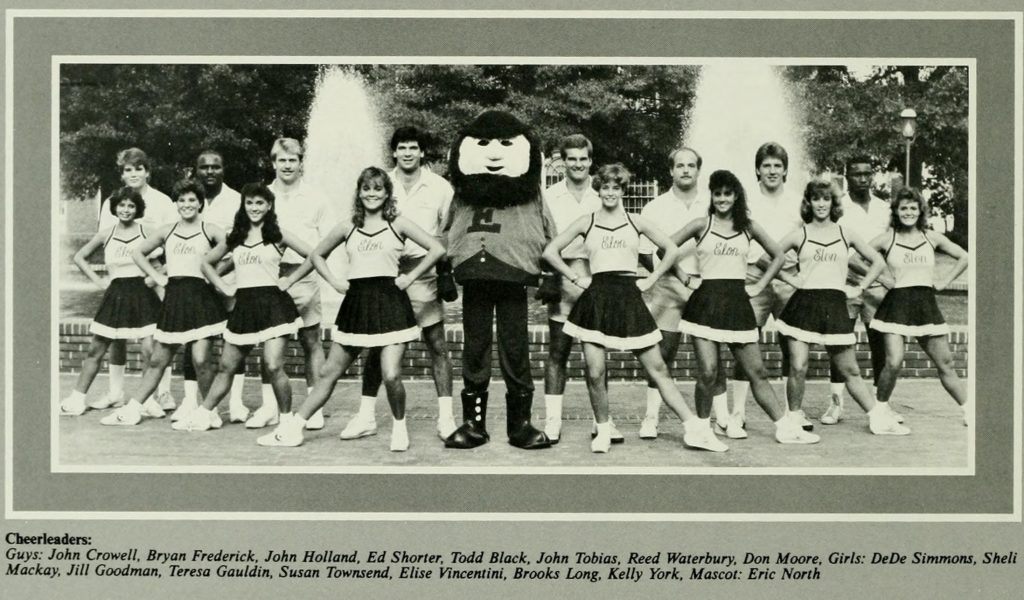
The Elon Fighting Christian mascot with cheerleaders. From the 1986 Phi Psi Cli yearbook.
Two schools break with the animal/human tradition in North Carolina. The Brevard College Tornadoes and the Louisburg College Hurricanes. Weather phenomena mascots are always difficult to pull off. I couldn’t find one for Brevard, but Louisburg, which currently has a bird mascot, had “Louie” up until 2006:
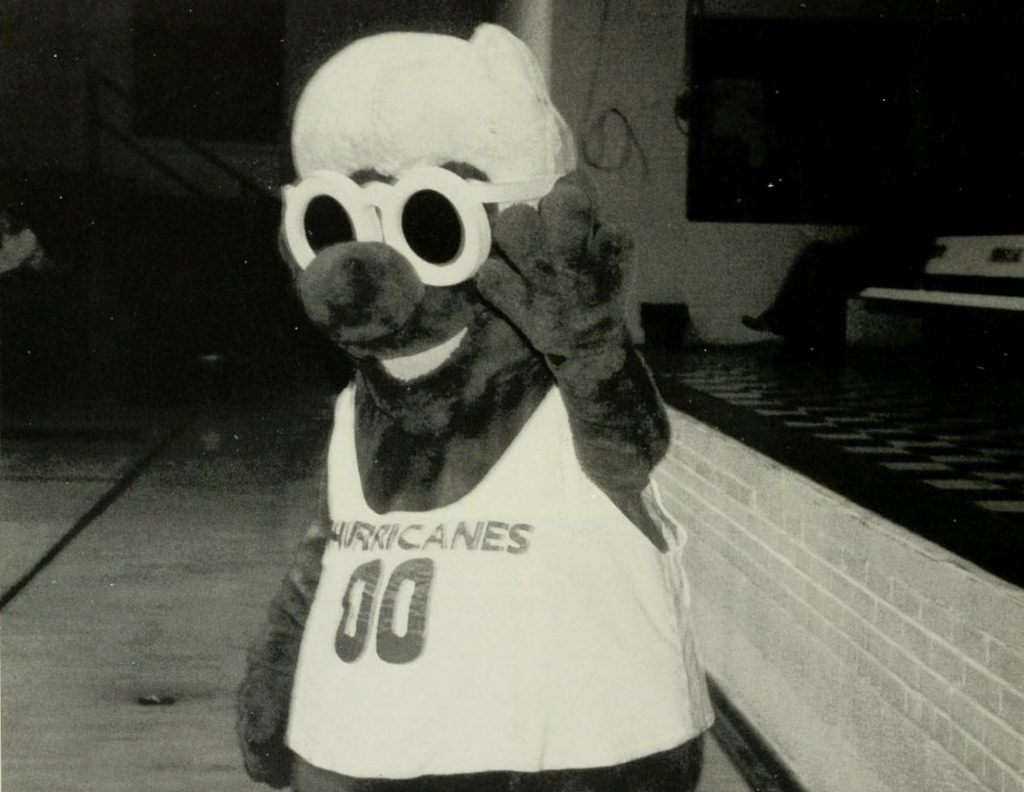
Louie, the former Louisburg College Hurricanes mascot. From the 1996 The Oak yearbook.
Who knows when the next mascot sea change will happen. Below is a list of mascots in North Carolina; let us know if we got anything wrong. Which one is your favorite?
| School |
Mascot |
Notes |
| Appalachian State University |
Yosef the Mountaineer |
First appeared in the yearbook in 1942 |
| Barton College |
Bulldog |
|
| Belmont Abbey College |
Crusader |
|
| Bennett College |
|
Known as the Bennett Belles |
| Brevard College |
Tornado |
|
| Campbell University |
Fighting Camels |
The Hornets in the 1920s-1930s |
| Catawba College |
Catawba Indian |
|
| Chowan University |
Hawks |
The Braves until 2006 |
| Davidson College |
Wildcats |
Also a bulldog (1929) and a bobcat (1939) |
| Duke University |
Blue Devil |
|
| East Carolina University |
Pirates |
Formerly Pee Dee the Pirate |
| Elizabeth City State University |
Vikings |
|
| Elon University |
Phoenix |
The Fightin’ Christians until 2000 |
| Fayetteville State University |
Broncos |
|
| Gardner-Webb University |
Runnin’ Bulldogs |
|
| Greensboro College |
The Pride |
Formerly the Hornets |
| Guilford College |
Quakers |
|
| High Point University |
Panthers |
|
| Johnson C. Smith University |
Golden Bulls |
|
| Lees-McRae College |
Wily the Bobcat |
|
| Lenoir-Rhyne University |
Joe and Josie Bear |
|
| Louisburg College |
Hurricanes |
|
| Mars Hill College |
Mountain Lion |
|
| Meredith College |
Avenging Angels |
Formerly the Angels |
| Methodist University |
Eagles |
|
| Montreat College |
Cavaliers |
|
| Mount Olive College |
Trojans |
|
| North Carolina A&T |
Aggie Dog (Bulldog) |
|
| North Carolina Central University |
Eagles |
|
| North Carolina State University |
Wolfpack |
|
| North Carolina Wesleyan College |
Battling Bishops |
Formerly the Circuit Riders |
| Peace College |
Pacer |
|
| Pfeiffer University |
Falcons |
|
| Queens University of Charlotte |
Rex the Royal |
|
| Saint Augustine’s University |
Mighty Falcons |
|
| Salem College |
Spirits |
|
| Shaw University |
Bears |
|
| St. Andrews University |
Knights |
|
| UNC Asheville |
Bulldog |
|
| UNC Chapel Hill |
Rameses the Ram |
Also known as the Tar Heels |
| UNC Charlotte |
Norm the Niner |
|
| UNC Greensboro |
Spartans |
|
| UNC Pembroke |
Braves |
|
| UNC Wilmington |
Seahawk |
|
| UNC School of the Arts |
Fighting Pickle |
|
| UNC School of Science and Math |
Unicorn |
|
| Wake Forest University |
Demon Deacons |
|
| Warren Wilson College |
Owls |
|
| Western Carolina University |
Catamount |
“Paws” |
| Wingate University |
Bulldog |
|
| Winston-Salem State University |
Ram |
|
The quote in this post’s title comes from a student who participated in a 1989 protest at UNC-Chapel Hill, pictured below.
One of the most historic student protests in the United States happened on this day in 1960 right here in North Carolina. NC A&T students protested segregation by sitting down at a segregated Woolworth’s lunch counter in Greensboro. The first images in this post were taken at that event and come from the 1960 Ayantee yearbook. Other images come from schools in all parts of the state, and date from 1960 through 2012.
North Carolina college students have passionately protested a variety of issues and events over the years. Looking back through yearbooks and student newspapers, you’ll find editorials with strong opinions and photographs of students standing up and speaking out in this most public of ways. Today we’re sharing the tradition of protest by students over the years, as reported in their own media.
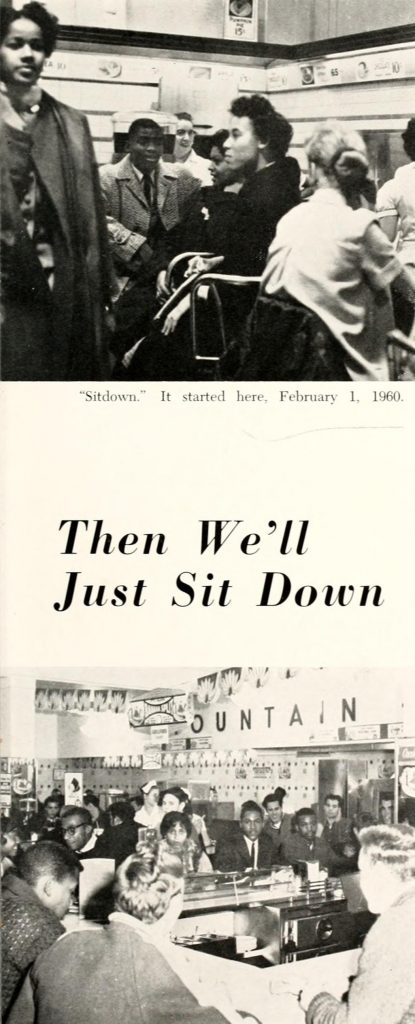
North Carolina Agricultural and Technical College, 1960, Segregation (Woolworth’s Lunch Counter, Greensboro)
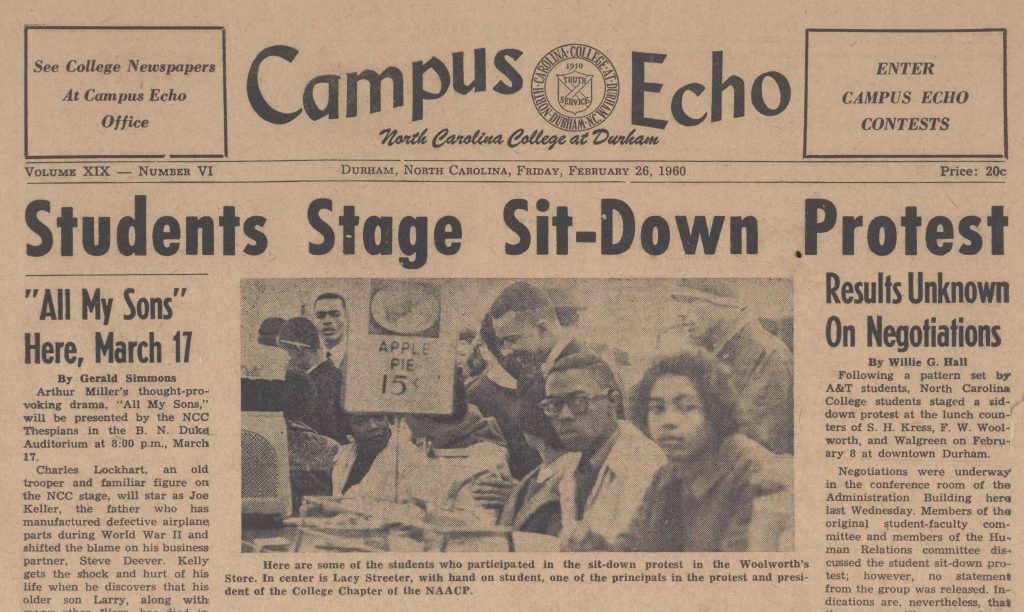
North Carolina Central University, 1960, Segregation (Woolworth’s Lunch Counter, Durham)
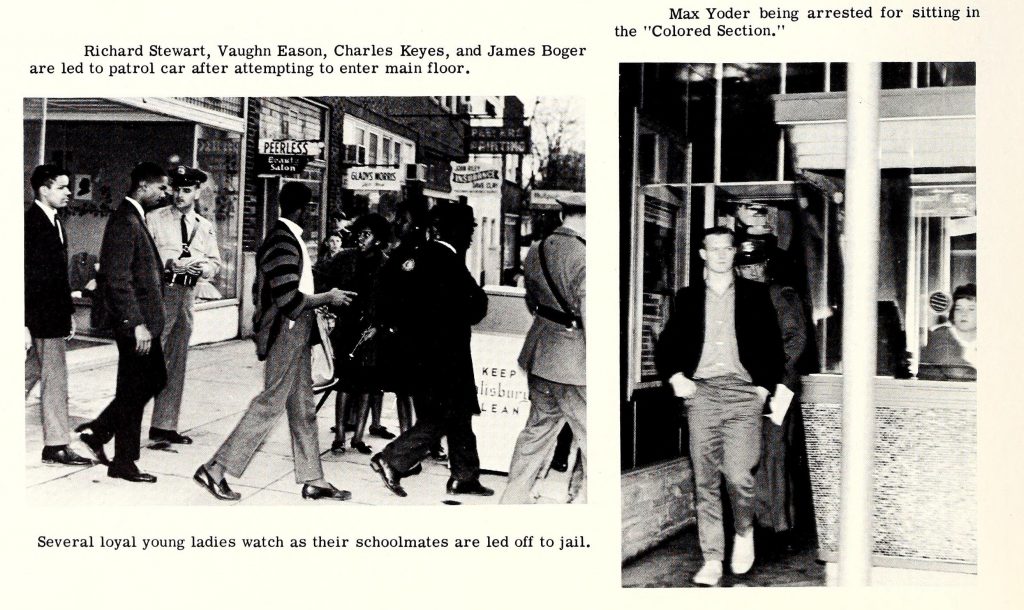
Livingstone College, 1961-1962, Segregation (Capitol Theater, Salisbury)
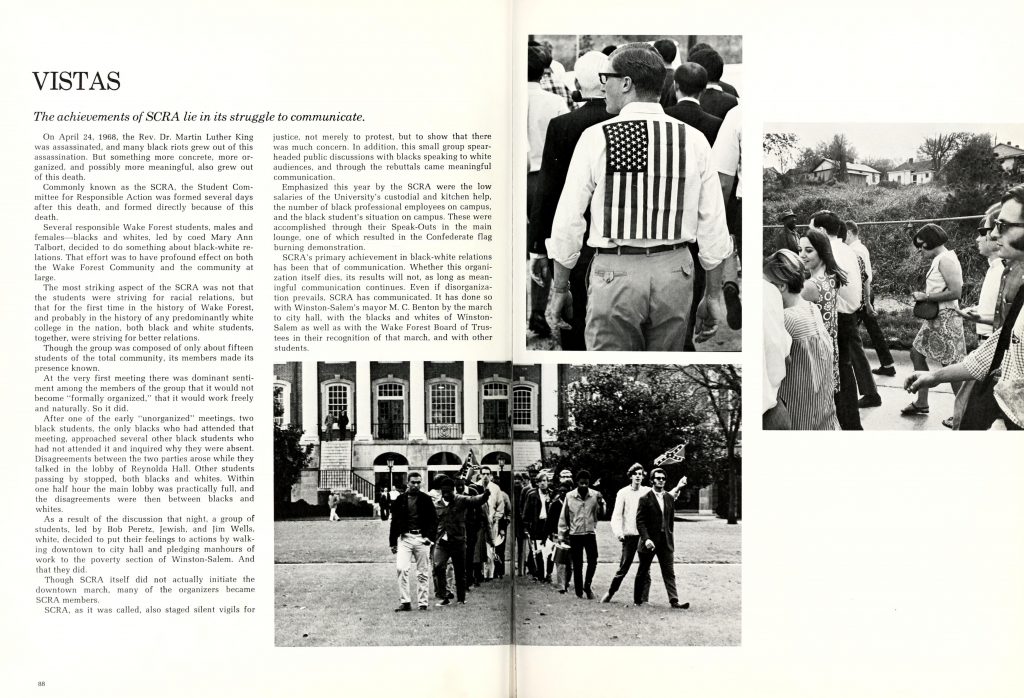
Wake Forest University, 1969, Assassination of Dr. Martin Luther King, Jr.
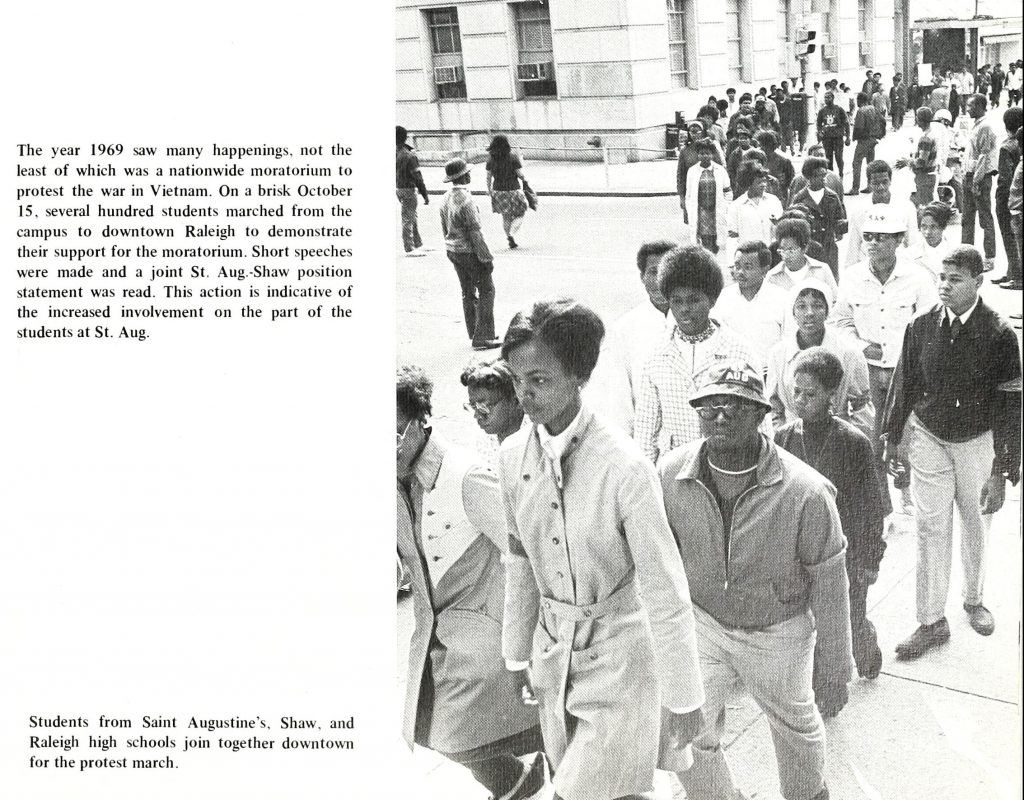
Saint Augustine’s, 1970, Vietnam War
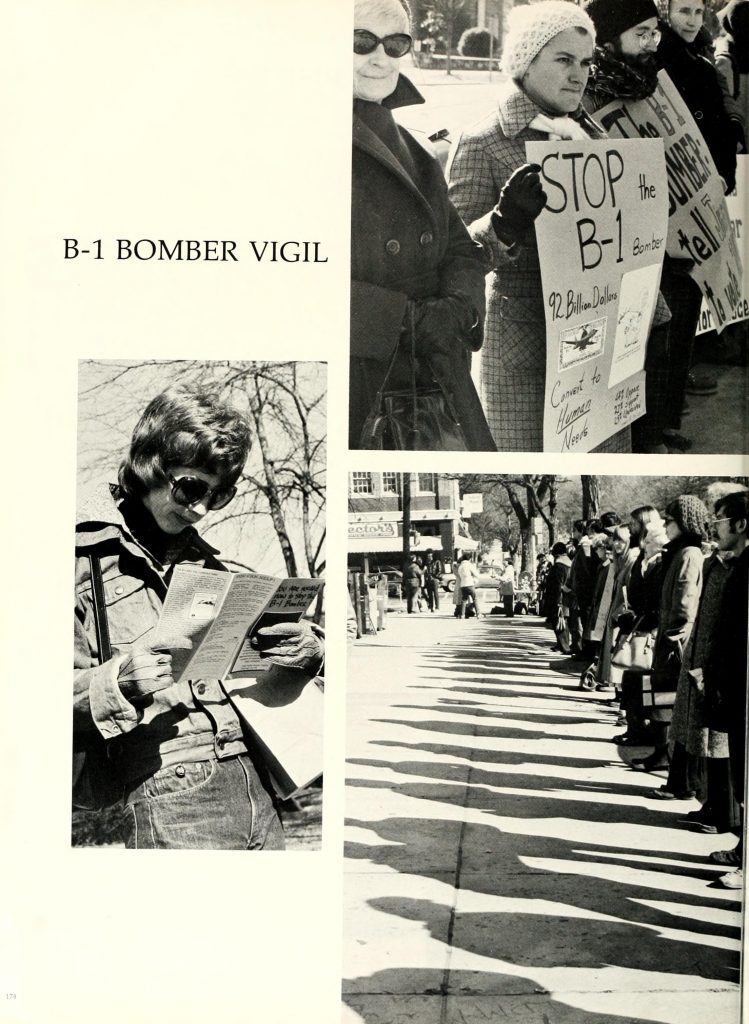
UNC-Chapel Hill, 1977, B-1 Bomber and Nuclear Armament
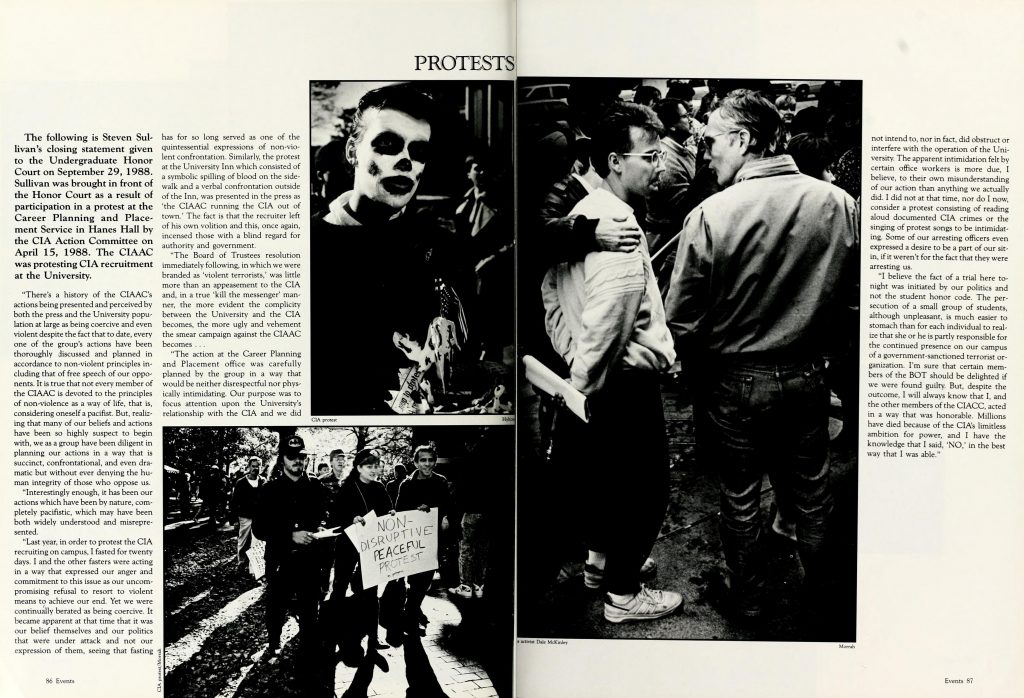
UNC-Chapel Hill, 1989, Central Intelligence Agency (CIA)
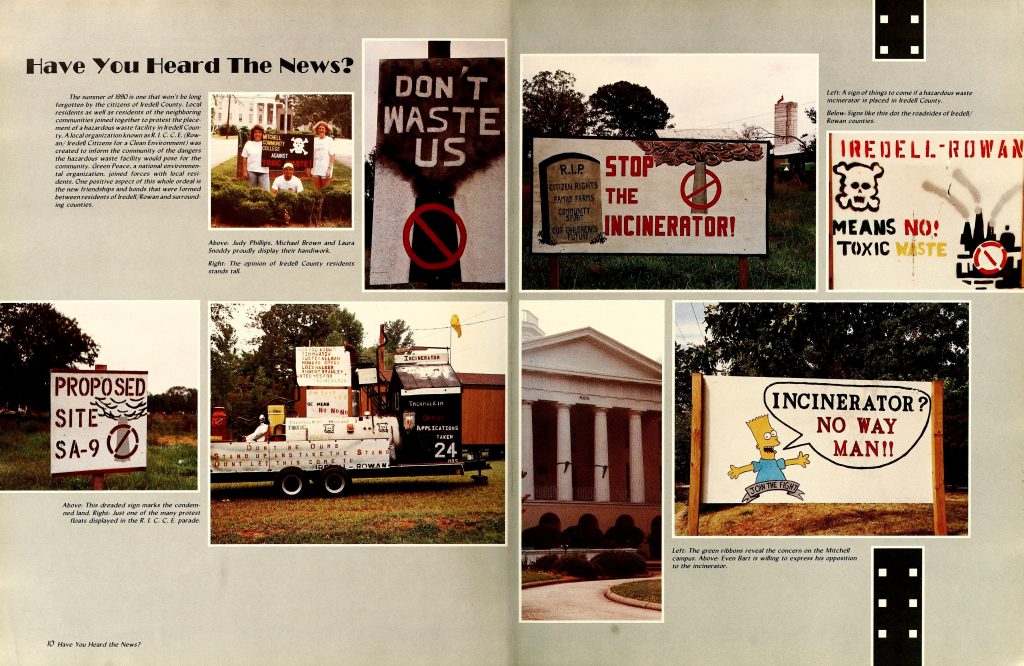
Mitchell Community College, 1990-1991, Hazardous Waste and Environmental Pollution
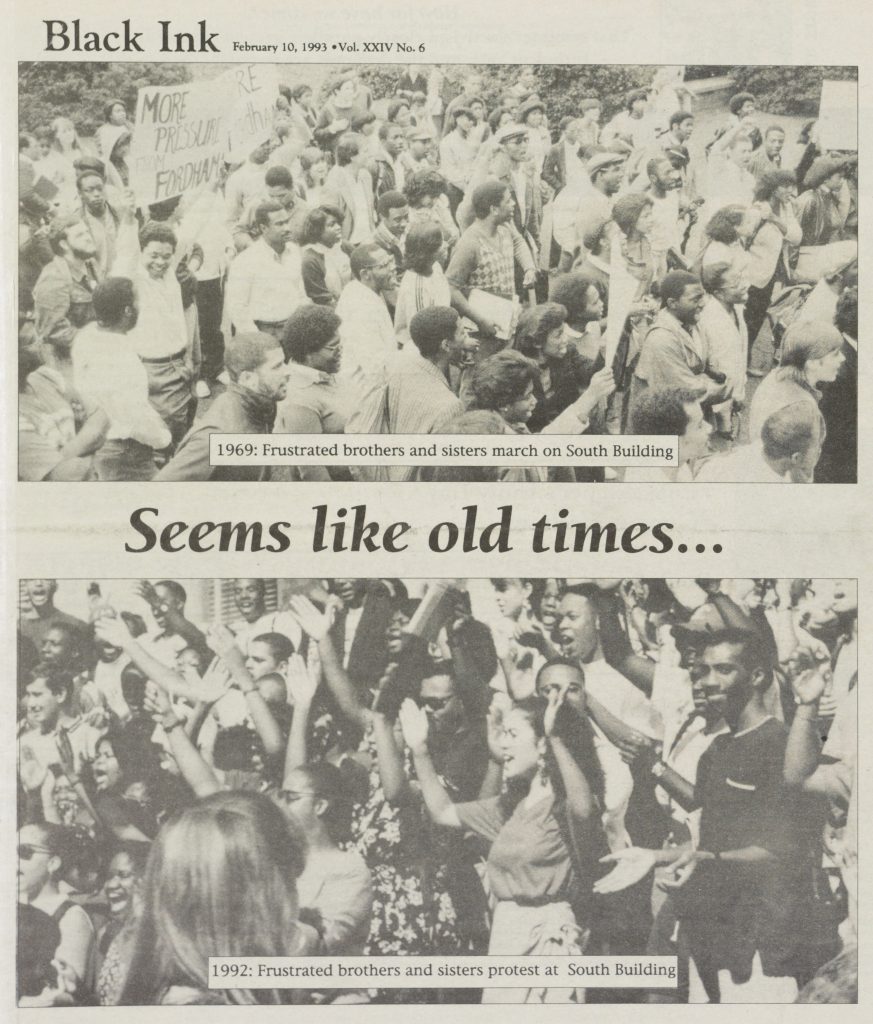
UNC-Chapel Hill, 1993, Racism
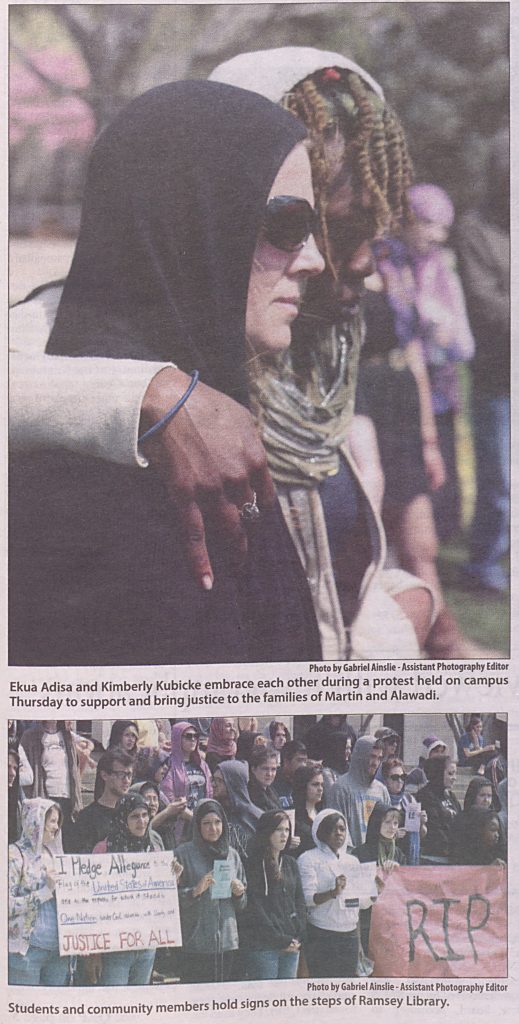
UNC-Asheville, 2012, Hate Crimes
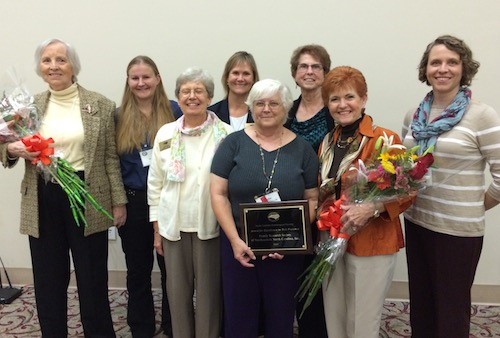
NCGS 2015 Award Winners at the Annual Luncheon in Raleigh. (left to right) Helen F. M. Leary, CG (Emeritus), FASG; Ginger R. Smith; Pam Toms, Awards Chair; Vickie P. Young, NCGS President; Sharon Gable; Maryann Stockert Tuck; Judi Hinton; and Lisa Gregory
On Saturday, at the North Carolina Genealogical Society Annual Meeting luncheon, we were honored as co-winners of the NCGS 2015 Award for Excellence in Web Presence.
We work hard to make sure our site represents the materials shared by our 180+ partners in a professional and easy-to-use manner, and are thrilled at the recognition from NCGS. It’s our hope that genealogists everywhere continue to find our site helpful for their research. We share this award with the State Library of North Carolina and the University of North Carolina at Chapel Hill, without whom our work wouldn’t be possible. Even more, we share this award with all of our partners, who are making their collections more accessible for users all over the world through DigitalNC.org.
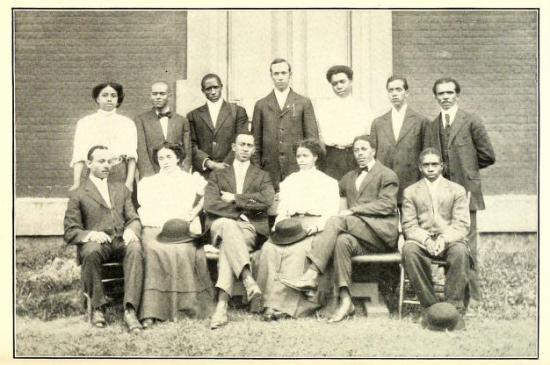
Students at Shaw University, 1911.
With the recent addition of student yearbooks from Livingstone College, DigitalNC now hosts historic materials from ten different Historically Black Colleges and Universities in North Carolina. These materials document more than a century of African American higher education in North Carolina. From our earliest projects in 2010 to the present, the North Carolina Digital Heritage Center has worked closely with libraries and archives at historically Black colleges around the state, and we continue to add materials from these collections on a regular basis. Follow the links below to browse yearbooks, newspapers, photos, scrapbooks, and more materials by school.
Bennett College (Greensboro)
Elizabeth City State University
Fayetteville State University
Johnson C. Smith University (Charlotte)
Livingstone College (Salisbury)
North Carolina A&T (Greensboro)
North Carolina Central University (Durham)
Saint Augustine’s University (Raleigh)
Shaw University (Raleigh)
Winston-Salem State University
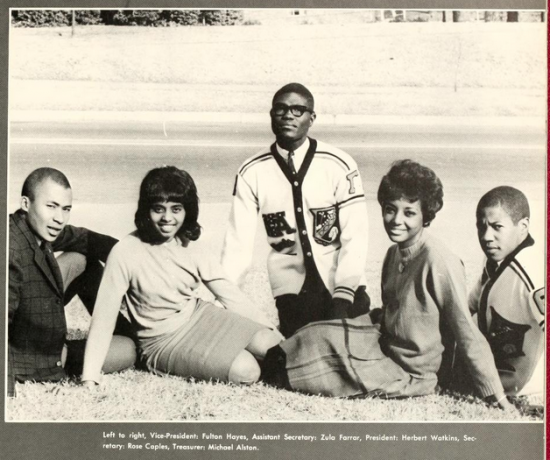
Sophomore class officers at North Carolina Central University, 1963.
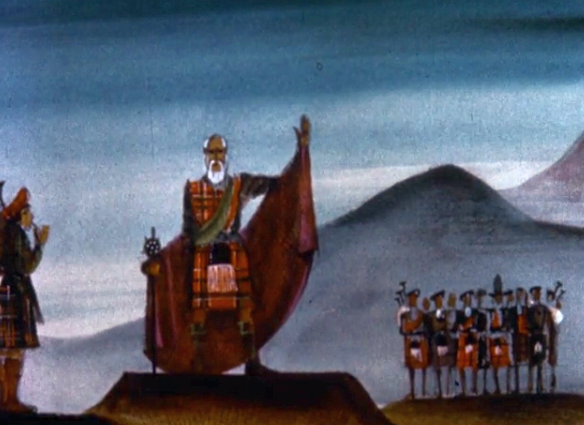
Film still from The Road to Carolina
In the early 1960s, North Carolina’s state government created a Film Board to “portray and illuminate the people, problems, themes, and life of the State” (Oettinger 1964/1965, p. 1). Championed by Governor Terry Sanford, the Board operated from 1962-1965 and created 19 films. As part of our recent audio-visual project, the Charlotte Mecklenburg Library and the North Carolina Collection at UNC-Chapel Hill’s Wilson Library contributed eight of these films for digitization.
During the Board’s operation, “ideas and requests for the films came from various state departments, individuals on the Governor’s staff or historical associations from around the state” (Ferrara 1981, p. 23). Production costs for each film averaged $30,000. James Beveridge, a filmmaker from Canada, was brought in to head the Board. (The State Archives has shared film clips from Beveridge online as well.)
The Board aimed to produce films that were documentary in nature, looking at different industries, locations, or segments of the population. Some addressed politically charged issues; the Minority Report series is a stark exploration of race relations. “Goodbye to Carolina,” was coordinated with the help of the Intercollegiate Council for Human Rights, chaired by then A&T student Jesse Jackson.
Below is a list of the films produced by the Board that are currently available on DigitalNC*:
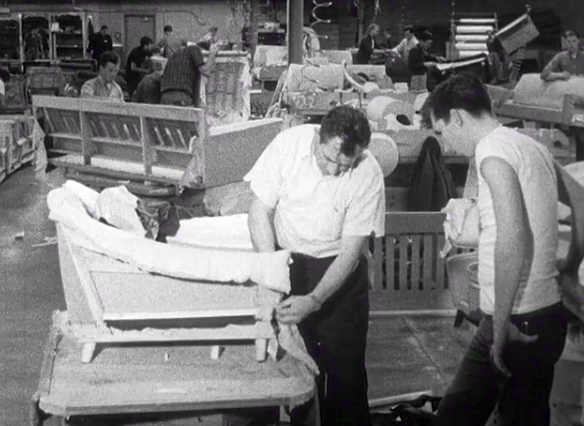
Film still from Welcome to Work
- The Ayes Have It (1963) A behind-the-scenes look at the North Carolina General Assembly.
- Minority Report: A Series Stating the Opinions and Experiences of Negro Students in North Carolina
- Goodbye to Carolina (1964) Interviews with North Carolina A&T College (now University) about their reasons for seeking jobs outside of North Carolina.
- A Knocking at the Gate (1964) Interviews with North Carolina College (now North Carolina Central University) students about civil rights.
- North Carolina’s Tribute to President John F. Kennedy (1964) Covers the memorial ceremonies for the late President held at UNC-Chapel Hill.
- The Road to Carolina (1963) Commissioned by the NC Tercentenary Commission and created for eight graders, this illustrated film recounts the first hundred years of the state’s colonial history.
- The Search for Excellence (1965) Follows rural residents’ experiences as communities around the state were consolidating educational resources and schools to a centralized model.
- The Vanishing Frontier (1963) The state’s Appalachian communities are documented through first-hand accounts with citizens, revealing the area’s “poverty and promise” (Ferrara, p. 28).
- Welcome to Work: The Siler City Story (1964) Describes the changes in Siler City as it transitioned from an agricultural-based to an industrial-based economy.
- Updated March 21, 2019
It’s interesting to see the film topics chosen during this time period. Instead of shying away from hot button issues or glossing over the widespread demographic, economic, and social changes of the era, the Film Board tackled them with a freer hand than might be expected. Such ambitious and frank efforts eventually contributed to the Board’s dissolution.
You can view additional items on DigitalNC from the Charlotte Mecklenburg Library and the University of North Carolina at Chapel Hill.
Notes
*The other films are: Land of Beginnings; Minority Report: Vote and the Choice is Yours; Minority Report: We’re Not Alone; Nine Months To Go; The Outer Banks (possibly lost, according to Ferrara)
References
Ferrara, Susan E. “The Demise of the North Carolina Film Board: Public Policy Implications.” M.A. thesis., University of North Carolina at Chapel Hill, 1981.
Oettinger, Elmer. “The North Carolina Film Board: A Unique Program in Documentary and Educational Film Making.” The Journal of the Society of Cinematologists 4/5 (1964/1965): p. 55-65.
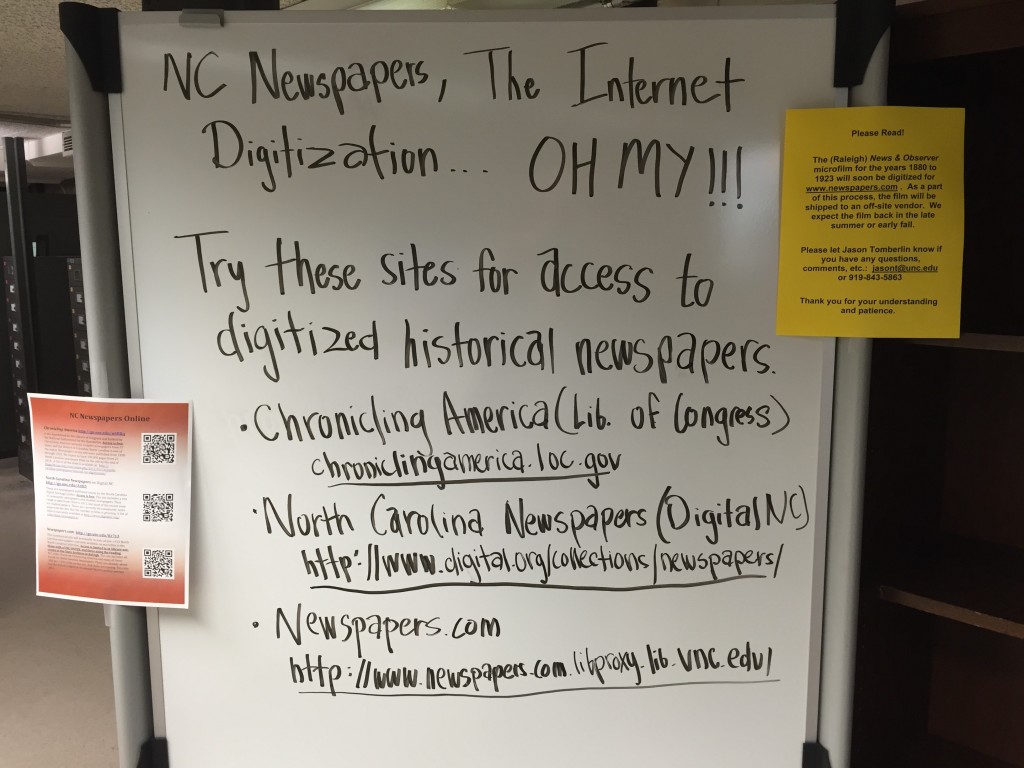
Sign pointing microfilm users to different online resources. Taken in Wilson Library’s North Carolina Collection Reading Room, UNC-Chapel Hill.
[This post updated July 2017.]
Newspaper digitization is challenging for a number of reasons (refer to our previous post). Although we’re biased, if you’re interested in accessing North Carolina newspapers online you’re actually pretty lucky; North Carolina is positioned well ahead of many other states. Below we’ve listed, in descending order of size, all of the major historic online newspaper databases sponsored by North Carolina institutions that are on our radar.
Name: Newspapers.com
Dates: 1751-2000
Coverage: Statewide
Amount Online: 3,500,000+ pages
Details: The North Carolina Collection at UNC-Chapel Hill Library recently partnered with Newspapers.com to digitize millions of pages of North Carolina newspapers. These are accessible for free at the State Archives of North Carolina or UNC-Chapel Hill’s Library, or you can view them anywhere at newspapers.com for a monthly fee. As of July 2017, NC LIVE also makes these papers available to member libraries and their card holders. While there are other vendors out there with historic North Carolina newspapers, this is the most comprehensive to date.
Name: The North Carolina Digital Heritage Center
Coverage: Statewide
Dates: 1824-2013
Amount Online: 640,000+ pages
Details: Each year we receive LSTA funding from the State Library of North Carolina to digitize newspapers. Part of that funding goes toward papers on microfilm, for which we ask for title nominations from libraries and archives. We also digitize some newspapers from print (mostly college and university student newspapers) as well as small runs of community papers that have not been microfilmed.
Name: The University of North Carolina at Chapel Hill, National Digital Newspaper Program Grant Award
Coverage: Statewide
Dates: 1836-1922
Amount Online: 100,000+ pages
Details: UNC-Chapel Hill is currently in its second round of providing selected historic newspapers for digitization and sharing through the Library of Congress’ Chronicling America website. These issues are searchable along with a selection of titles from other states.
Name: University of North Carolina at Greensboro Library / Greensboro Museum
Dates: 1826-1946
Coverage: Town of Greensboro and surrounding area
Amount Online: 5,000+ issues
Details: The Greensboro Historical Newspapers collection includes a variety of papers from that area, including World War II military base papers.
Name: The State Archives of North Carolina
Dates: 1752-1890s
Coverage: Statewide
Amount Online: 4,000+ issues
Details: The State Archives of North Carolina actively preserves, microfilms, and digitizes newspapers. While most of these are not currently available online, they have shared some of the earliest on their website.
Name: East Carolina University Library
Dates: 1887-1915
Coverage: Town of Greenville and surrounding area
Amount Online: 1,800+ issues
Details: ECU’s Digital Collections include The Eastern Reflector, a community paper published in Greenville.
While more focused, college and university papers (especially earlier issues) often included local community news. In addition to those featured on DigitalNC, here’s a list of other school papers online:
This isn’t to say others aren’t scanning their local newspapers – we know some heard of local entities (businesses and libraries) working toward that goal. But this post was intended to list the largest, statewide, and (mostly) freely searchable endeavors. Know of others? Tell us.
In Part 3 of this Newspaper Digitization series, we’ll get technical and describe how we digitize newspapers here at the Digital Heritage Center.
Two related notes:
- Looking for a newspaper that isn’t online (yet)? Through your local public library, you can most likely loan and view newspaper microfilm from the State Library of North Carolina. This Newspaper Locator may be helpful if you want to determine some of the titles published in a specific area.
- North Carolinians are heavily involved in efforts to preserve born-digital news. The Educopia Institute, located in Greensboro, is spearheading a conversation that brings in news producers and cultural heritage professionals to talk about our disappearing journalistic heritage. At their website you can learn more about the Memory Hole events and read a white paper on Newspaper Preservation.
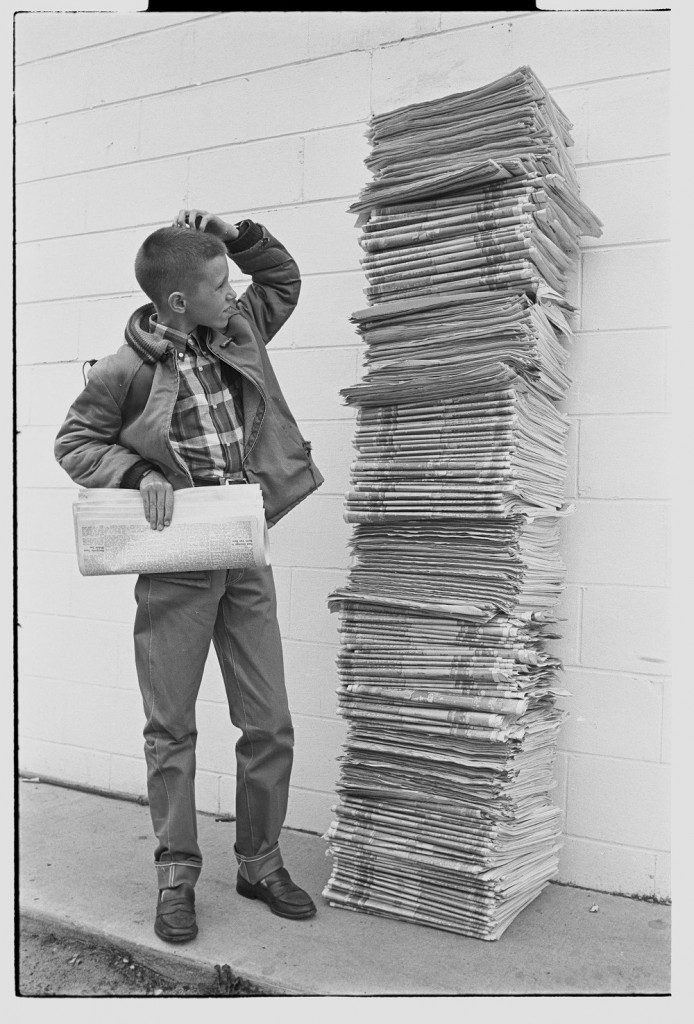
Carrier boy with newspapers. 1965, Courtesy East Carolina University Digital Collections
Here’s what we know:
- Researchers love newspapers.
- Libraries and archives love newspapers.
- North Carolina has produced a lot of newspapers.
- No, really. There. are. a. lot.
Well, we do know a little bit more than that, but those are the Cliff’s Notes of our newspaper story. Because we work with so many papers, we try and stay on top of what’s happening with newspaper digitization in the state and around the country. We thought we’d write a few blog posts to share some of what we’ve seen and are seeing in that area, and to help get the word out that there’s a lot happening in this space in North Carolina.
So, why is digitizing and sharing newspapers online so tough?
Quantity
There are a lot of them. We’re saying it once more simply because it is the most costly factor in digitization and preservation. Let’s take, for example, a weekly newspaper published from 1870-1920. That’s over 2,500 issues. Say each issue is 8 pages long. Now we’re up to 20,000+ pages. And let’s say there’s one of those types of papers in every county. We’re already at 2 million pages for the state, for only 50 years. This is hugely conservative, considering many counties had more than one paper. And we didn’t even talk about papers published by schools, companies, or ambitious individuals. Or about dailies…
By our estimation, digitization of just the microfilmed newspapers located in the North Carolina Collection at UNC-Chapel Hill would result in over 40 million pages, which means 40 million digitized images. That could be upwards of 180 TB of data. For JUST storage (not including serving this up to the web, maintenance, staff) you’d pay a paltry $6,000 per month*.
We kid you not.
Size
Beside quantity, the remaining challenges look petite. Broadside newspaper pages need a larger scanner than most institutions can afford, especially if the papers are bound. Tabloid sized pages won’t fit on typical flatbed scanners either, and we rarely recommend flatbeds for something like this because they’re just too slow.
Material
Although uniform, which is a plus, historic newspapers can be fragile, friable, and fiddly. The more carefully you have to handle material when you digitize, the more time you’re going to need.
Text-Heavy
Having images of newspapers is really helpful. It’s portable, physically compact, and easier to copy. But the true advantage of a digital version is when it’s full-text searchable. Full-text searchability across large quantities of files requires indexing and search software, and enough IT infrastructure to make that happen.
Rights
While most newspapers published before 1923 can be safely shared online, those published in the years since can have attendant rights issues (pun intended). The massive changes in newspaper ownership over the last 20 years can make institutions wary about publishing a paper from 1924 or 1994.
Oh My.
Hopefully it’s clearer now why more historic newspapers aren’t yet freely available online. Albeit daunting, the challenges mentioned above are all surmountable with enough resources (money and expertise) and time. In our next blog post we’ll highlight where you can find historic North Carolina newspapers online right this very minute.
* We’re quoting Amazon S3 storage here, but YMMV.







































